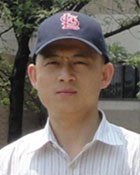
Professor
Email: xdcrun@zju.edu.cn
Dr. Xiaodong Chen obtained his PhD Degree from Institute of Neuroscience, The Chinese Academy of Science in 2008. From2008-2009, he became the assistant research in Dr. Muming Pu's lab in The Chinese Academy of Science. From 2009-2014, Dr. Chen got his Post-Doctor position in Dr. Dora E. Angelaki‘s lab in both Washington University and Baylor Medical School. In February 2014, he joined ZIINT and studies the mechanism of Spatial perception and object recognition.
Research Interests:
The activity of human brain solves two basic questions: "Where" and "what." Brain research shows that parietal and temporal cortices play important roles in the function of object recognition and spatial encoding respectively. Our group will combine the research method of electrophysiological recordings, functional magnetic resonance imaging (fMRI), and optical genetic etc. to study the neural mechanism of these functions by recording and analyzing response characteristics of these cortical neurons. Our researches include the following directions:
The spatial encoding of sensory input signals in the brain
In order to control our own movement and interact with the environment, the brain needs to be updated in real time the status information of all body parts and surrounding environment in space. The information was perceived by various receptors of the body, then transferred into the brain and integrated there to be involved in the development of the sport and the movement controlling of body parts. The parietal cortex is thought to play a key role in this process. The cortical neurons in this area receive input signals from multiple sensory systems (including visual, vestibular, auditory, and somatosensory). In different regions of the parietal cortex, these signals are encoded in different spatial coordinate systems. We will systematically study the spatial encoding of sensory signals in these brain regions, and then in further to explore these sensory signals coded in different coordinate systems are integrated through what kind of mechanisms.
Neural mechanisms of object recognition
Neurons in the temporal cortex receive input signals primarily from visual and auditory systems and play important roles in the advanced functions of pattern recognition, object recognition, memory, and languages. In particular, recent studies suggested that neurons in certain areas of the temporal cortex show very specific responses to facial stimuli. Fatherly, we will use newly designed facial stimuli to explore the neural mechanisms of the face recognition.
Development of auxiliary research tools
We will develop corresponding hardware and software tools based on the requirements of our research to assist our experiments.
Selected Publications:
1. Chen, X., F. Han, et al. (2007). "Excitatory and suppressive receptive field subunits in awake monkey primary visual cortex (V1)." Proc Natl Acad Sci U S A 104(48): 19120-19125.
2. Chen, X., G. C. DeAngelis, et al. (2013). "Eye-centered representation of optic flow tuning in the ventral intraparietal area." J Neurosci 33(47): 18574-18582.
3. Chen, X., G. C. DeAngelis, et al. (2013). "Diverse spatial reference frames of vestibular signals in parietal cortex." Neuron 80(5): 1310-1321.
4. Chen, X., G. C. Deangelis, et al. (2014). "Eye-centered visual receptive fields in the ventral intraparietal area." J Neurophysiol.
< Back

